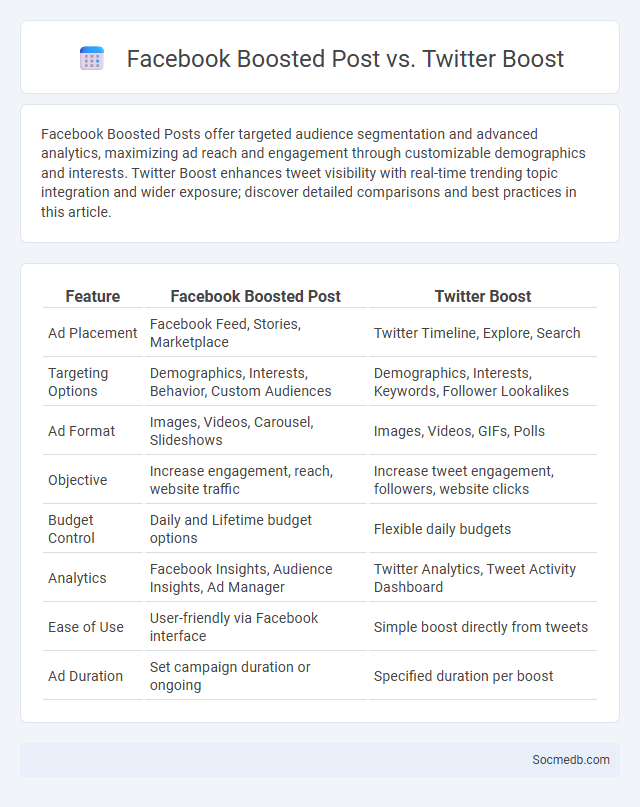
Photo illustration: Facebook Boosted Post vs Twitter Boost
Facebook Boosted Posts offer targeted audience segmentation and advanced analytics, maximizing ad reach and engagement through customizable demographics and interests. Twitter Boost enhances tweet visibility with real-time trending topic integration and wider exposure; discover detailed comparisons and best practices in this article.
Table of Comparison
| Feature | Facebook Boosted Post | Twitter Boost |
|---|---|---|
| Ad Placement | Facebook Feed, Stories, Marketplace | Twitter Timeline, Explore, Search |
| Targeting Options | Demographics, Interests, Behavior, Custom Audiences | Demographics, Interests, Keywords, Follower Lookalikes |
| Ad Format | Images, Videos, Carousel, Slideshows | Images, Videos, GIFs, Polls |
| Objective | Increase engagement, reach, website traffic | Increase tweet engagement, followers, website clicks |
| Budget Control | Daily and Lifetime budget options | Flexible daily budgets |
| Analytics | Facebook Insights, Audience Insights, Ad Manager | Twitter Analytics, Tweet Activity Dashboard |
| Ease of Use | User-friendly via Facebook interface | Simple boost directly from tweets |
| Ad Duration | Set campaign duration or ongoing | Specified duration per boost |
Facebook Boosted Post vs Twitter Boost: An Overview
Facebook Boosted Posts offer precise audience targeting through demographics, interests, and behaviors, resulting in higher engagement rates and better conversion tracking compared to Twitter Boosts. Twitter Boosts prioritize real-time interaction and trending topics, benefiting brand awareness and immediate reach but often show less detailed targeting options than Facebook. Marketers typically find Facebook Boosted Posts more effective for lead generation, while Twitter Boosts excel in amplifying content during live events and conversations.
What is a Facebook Boosted Post?
A Facebook Boosted Post is a paid advertisement that amplifies the reach of an organic post by targeting a specific audience based on demographics, interests, and behaviors. This tool increases post visibility beyond the current followers, driving higher engagement and potential conversions. Advertisers can set budgets, durations, and objectives to optimize campaign performance efficiently.
What is Twitter Boost (Promoted Tweet)?
Twitter Boost, also known as Promoted Tweet, is a paid advertising feature that enhances the visibility of your tweets by displaying them to a broader audience beyond your followers. This service targets specific demographics and user interests, increasing engagement, impressions, and click-through rates for your content. By leveraging Twitter Boost, you can effectively amplify your brand message and drive more traffic to your profile or external links.
Key Features: Facebook vs Twitter Boost
Facebook offers advanced targeting options, including demographic, interest, and behavior-based filters, allowing advertisers to reach highly specific audiences. Twitter Boost emphasizes real-time engagement and trending topics, boosting tweets to increase visibility among relevant users during peak activity periods. Both platforms provide robust analytics to measure campaign performance and optimize ad spend effectively.
Audience Targeting: Facebook and Twitter Compared
Facebook excels in audience targeting by leveraging extensive user data, including demographics, interests, and behaviors, allowing advertisers to create highly segmented campaigns. Twitter offers keyword and hashtag targeting, enabling brands to engage with real-time conversations and niche communities, though its data depth is less comprehensive than Facebook's. Both platforms support lookalike audiences, but Facebook's advanced algorithms typically deliver more precise reach and conversion metrics.
Cost and Budgeting Differences
Social media advertising costs vary significantly based on platform, targeting options, and campaign goals, with budgets ranging from a few dollars per day to thousands monthly. You should allocate your budget strategically by analyzing cost-per-click (CPC) and cost-per-impression (CPM) metrics to maximize return on investment. Understanding these budgeting differences ensures your marketing spend effectively drives engagement and conversions across channels like Facebook, Instagram, and LinkedIn.
Analytics and Performance Tracking
Social media analytics and performance tracking leverage data metrics such as engagement rate, click-through rate, and follower growth to optimize content strategy and audience targeting. Advanced tools like Facebook Insights, Twitter Analytics, and Google Analytics provide real-time dashboards that enable businesses to monitor campaign effectiveness and user behavior. By interpreting key performance indicators (KPIs) including impressions, conversions, and sentiment analysis, marketers enhance ROI and drive data-driven decision-making.
Which Platform Delivers Better Engagement?
Instagram consistently delivers higher engagement rates compared to other social media platforms, with an average engagement rate of 1.22% per post, driven by its visual content focus and Stories feature. TikTok shows rapid growth in user interaction, boasting an average engagement rate of 5.3% on brand posts thanks to its short-form video format that encourages viral sharing. Facebook, while having the largest user base, has lower engagement rates, averaging around 0.08%, making it less effective for organic reach but valuable for targeted advertising campaigns.
When to Use Facebook Boost vs Twitter Boost
Facebook Boost is ideal for targeted local campaigns and audience engagement due to its advanced demographic filters and extensive user base exceeding 2.9 billion monthly active users. Twitter Boost suits real-time event promotions and trending topics, leveraging its strength in timely content distribution and engagement with approximately 450 million active users. Choosing between the two depends on campaign goals: Facebook excels in detailed targeting and lead generation, while Twitter amplifies instant visibility and conversations.
Final Verdict: Choosing the Right Boosted Post Strategy
Choosing the right boosted post strategy on social media hinges on targeting the ideal audience and aligning the content with your brand goals. Your budget allocation should focus on platforms where your demographic is most active to maximize engagement and conversion rates. Testing different formats and analyzing performance metrics will help refine your approach for optimal return on investment.
 socmedb.com
socmedb.com